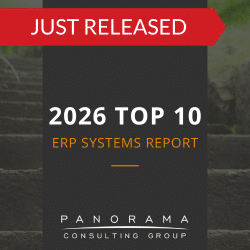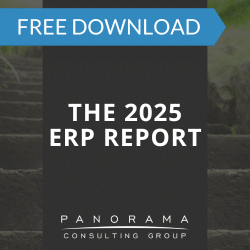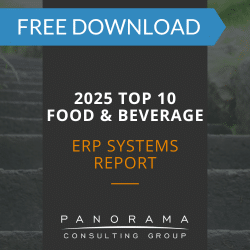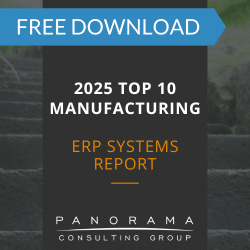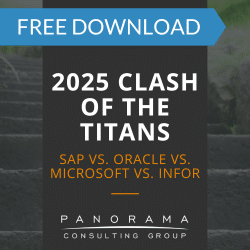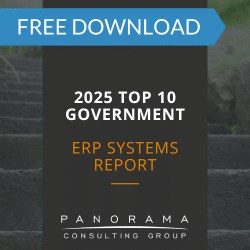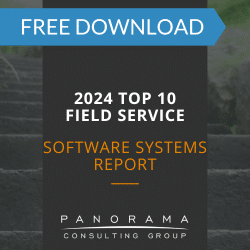Key Takeaways
- SCM software trends include capabilities like demand sensing, AI-driven optimization, and sustainability dashboards that influence cost efficiency, resilience, and compliance.
- Supply chain software features, such as end-to-end visibility and control towers, are shaping how organizations reduce risk, improve service levels, and enhance decision-making.
- An SCM software evaluation often uncovers differences in how vendors define the same buzzwords, impacting both ROI potential and total cost of ownership.
- Evaluating supply chain software features in context helps leaders connect technology capabilities to strategic priorities like growth, customer satisfaction, and operational agility.
Supply chain management (SCM) software evaluations often include a whirlwind of demos, proposals, and vendor presentations. Alongside legitimate capabilities, you’ll hear a steady stream of buzzwords. Some point to genuine strategic opportunities; others are vague promises without operational depth.
As leaders weigh SCM software trends and features, the challenge is separating marketing gloss from meaningful value. This guide explains common buzzwords, why they matter, and the questions you can ask to reveal their real-world impact during your SCM software evaluation.
2025 Clash of the Titans
SAP, Oracle, Microsoft, and Infor each have a variety of systems that can support data-driven decision-making. We surveyed customers of these four vendors to find out what their selection and implementation process was like.
1. End-to-End Visibility
This is one of the most common phrases vendors use when discussing supply chain software features. Vendors promise a “single pane of glass” for tracking orders, inventory, and supplier performance from procurement to final delivery.
When executed well, end-to-end visibility can transform decision-making. It enables proactive responses to disruptions, faster customer updates, and greater inventory accuracy.
However, our ERP implementation consultants have found that the scope varies widely between vendors—some focus on real-time shipment tracking, while others emphasize deep analytics on supplier performance.
For example, a food and beverage manufacturer might evaluate two platforms that both claim full visibility. One offers real-time shipment GPS data but limited inventory reconciliation. The other integrates production data, quality metrics, and supplier scorecards. Both use the same buzzword, but the operational value differs.
Questions to ask vendors:
- Which specific data sources are included in “end-to-end” tracking?
- How frequently is the data refreshed?
- Can you demonstrate a scenario where a disruption was resolved faster due to your visibility features?
2. Demand Sensing
One common buzzword related to current SCM software trends is “demand sensing.” Demand sensing functionality uses short-term data—such as recent sales, weather patterns, or social media signals—to refine forecasts. Vendors highlight it as a way to stay agile in volatile markets.
The promise is compelling: reduced stockouts, less excess inventory, and better alignment between production and demand. Yet demand sensing depends on both the quality of data and the organization’s ability to act quickly on forecast changes.
For example, a fashion retailer might adopt a platform with demand sensing to adjust production orders mid-season based on trending styles. Without agile manufacturing partners, though, those insights could arrive too late to matter.
Questions to ask vendors:
- What external data sources feed your demand sensing models?
- How quickly can forecast updates be pushed to production planning?
- Can your system highlight confidence levels in its predictions?
3. Control Tower
A control tower is positioned as the “mission control” for supply chains—centralizing data, alerts, and performance metrics. In theory, it enables better collaboration across functions and faster responses to disruptions.
In reality, control tower implementations vary dramatically. Some are dashboards with limited actionability; others allow you to trigger workflows, reroute shipments, or adjust schedules directly from the interface.
For example, a consumer electronics distributor might compare two control tower solutions. One provides a high-level status board but requires logging into separate modules to act. The other allows direct intervention from the control tower, reducing delays.
Questions to ask vendors:
- What actions can be initiated directly from the control tower?
- How does your control tower integrate with ERP and manufacturing execution systems?
- Can you provide an example where the control tower reduced lead times or prevented an order delay?
4. Digital Twin
Digital twin technology in supply chain management creates a virtual model of your supply chain—enabling scenario testing, risk modeling, and optimization without disrupting live operations. It’s gaining traction in SCM software evaluation discussions, especially for complex global networks.
When used strategically, digital twins can reveal vulnerabilities before they become crises and model the impact of supplier changes and demand spikes. But without accurate, up-to-date data, the model becomes an expensive static diagram.
For example, an automotive parts supplier might use a digital twin to model the effect of a raw material shortage in one region, testing alternate supplier routes before disruption hits.
Questions to ask vendors:
- How often is the digital twin updated with live operational data?
- What level of process and network detail can the model represent?
- Can you show a case where your digital twin helped avoid a disruption?
5. Multi-Enterprise Collaboration Platform
This term appears more often in enterprise-focused SCM software evaluations, but its value applies to mid-market organizations as well. It refers to a shared digital workspace for suppliers, carriers, and customers.
When implemented effectively, it streamlines communication, reduces email chains, and enables joint problem-solving in real time. The challenge is adoption—partners must be willing to use it consistently.
For example, an industrial equipment manufacturer might onboard its top 20 suppliers to a collaboration platform for shared demand planning. If only half engage, the benefits are diluted and ROI falls short.
Questions to ask vendors:
- How do you encourage supplier and customer adoption of the platform?
- What permissions and security measures are in place for sensitive data?
- Can the platform integrate with partner systems to reduce duplicate data entry?
6. Sustainability Dashboard
Sustainability is now a core part of many supply chain software features, especially for companies facing ESG reporting requirements. A sustainability dashboard consolidates environmental impact metrics such as carbon emissions, water usage, and waste.
While this is valuable for compliance and brand reputation, accuracy hinges on supplier data transparency and standardized measurement methods.
For example, a global beverage company might use a sustainability dashboard to track emissions per shipment lane. But, without cooperation from carriers and suppliers, the dashboard may rely on estimates that produce an incomplete picture that overstates performance in some regions and understates it in others.
Questions to ask vendors:
- How do you verify supplier-reported environmental data?
- Can metrics be broken down by product line, region, or supplier?
- How does your system align with emerging ESG reporting standards?
7. AI-Driven Optimization
AI is a mainstay in modern SCM software trends. Vendors apply it to everything from dynamic routing to automated procurement.
Executives are drawn to the potential efficiency gains, but “AI” can mean anything from simple rule-based automation to advanced machine learning.
For example, a chemical manufacturer might adopt AI-driven optimization for transportation routes. If the AI is truly adaptive, it could adjust routing in response to fuel prices, port congestion, and delivery windows. If it’s rules-based, the benefits may plateau at predefined route templates that can only recalculate based on static distance and cost assumptions.
Even with modern, advanced AI, the benefits can be elusive. An AI Readiness Assessment is essential for identifying data gaps, process constraints, and organizational capabilities that determine whether AI will deliver the expected ROI.
Questions to ask vendors:
- What specific AI techniques are used (machine learning, neural networks, optimization algorithms)?
- How does the AI learn and improve over time?
- Can you show before-and-after performance metrics from a live deployment?
Learn More About SCM Software Evaluation
Buzzwords can signal valuable innovations—or distract from gaps in capability. The key during an SCM software evaluation is to drill into operational detail, test features against real-world scenarios, and involve cross-functional stakeholders early.
Independent ERP consultants, free from vendor incentives, can help you assess SCM software trends and supply chain software features with a clear, unbiased lens. This ensures your decision is grounded in the realities of your supply chain, not just the language of the latest sales pitch. Contact us below to learn more.


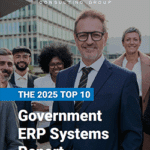


![Buzzwords You’ll Encounter in an SCM Software Evaluation [& Questions to Ask]](https://www.panorama-consulting.com/wp-content/uploads/2025/08/SCM-software-evaluation.png)
